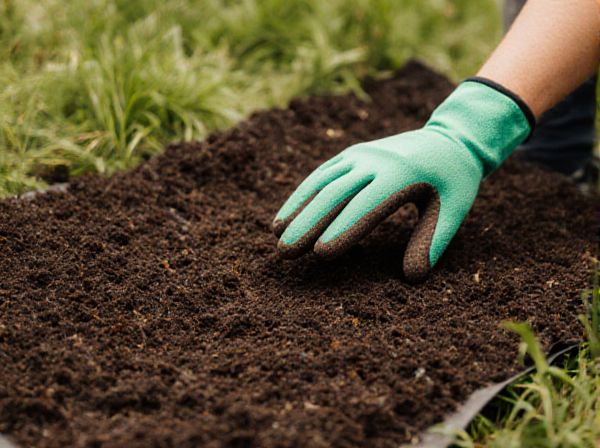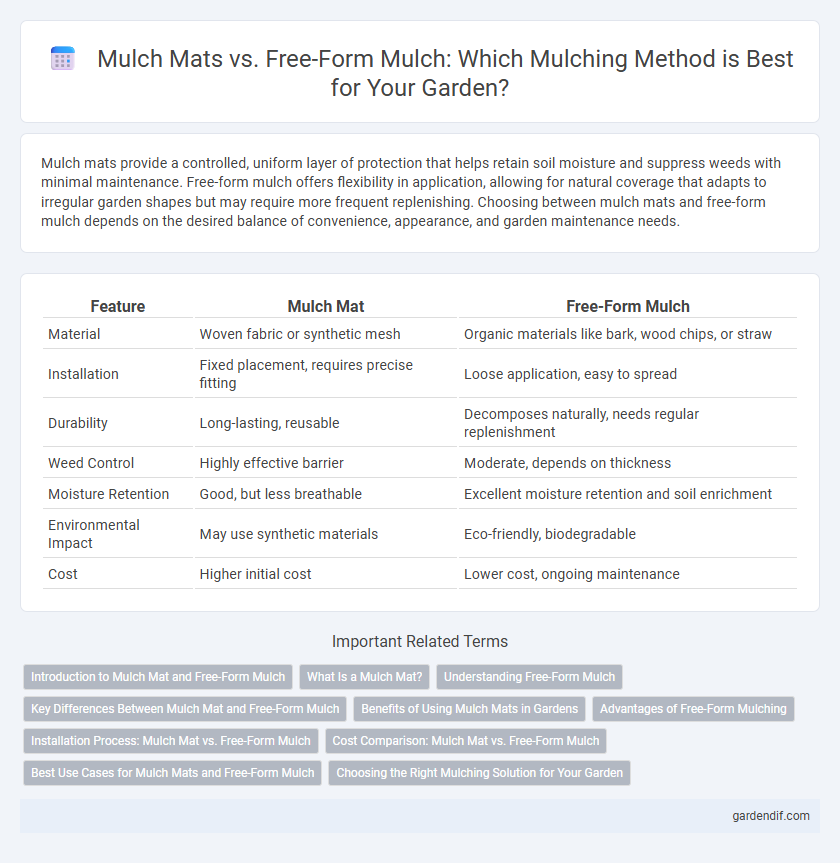
Mulch mat vs Free-form mulch Illustration
Mulch mats provide a controlled, uniform layer of protection that helps retain soil moisture and suppress weeds with minimal maintenance. Free-form mulch offers flexibility in application, allowing for natural coverage that adapts to irregular garden shapes but may require more frequent replenishing. Choosing between mulch mats and free-form mulch depends on the desired balance of convenience, appearance, and garden maintenance needs.
Table of Comparison
| Feature | Mulch Mat | Free-Form Mulch |
|---|---|---|
| Material | Woven fabric or synthetic mesh | Organic materials like bark, wood chips, or straw |
| Installation | Fixed placement, requires precise fitting | Loose application, easy to spread |
| Durability | Long-lasting, reusable | Decomposes naturally, needs regular replenishment |
| Weed Control | Highly effective barrier | Moderate, depends on thickness |
| Moisture Retention | Good, but less breathable | Excellent moisture retention and soil enrichment |
| Environmental Impact | May use synthetic materials | Eco-friendly, biodegradable |
| Cost | Higher initial cost | Lower cost, ongoing maintenance |
Introduction to Mulch Mat and Free-Form Mulch
Mulch mats are pre-cut, durable sheets made from woven or non-woven materials designed to suppress weeds and retain soil moisture efficiently around plants. Free-form mulch consists of organic materials such as wood chips, straw, or bark spread loosely over the soil surface to provide insulation and improve soil health. Both methods serve to protect plant roots and enhance garden aesthetics but differ in installation, maintenance, and longevity.
What Is a Mulch Mat?
A mulch mat is a pre-cut, durable covering made from synthetic or natural fibers designed to suppress weeds and retain soil moisture around plants. Unlike free-form mulch, which is loosely applied organic material like wood chips or straw, mulch mats provide a stable, uniform barrier that prevents erosion and reduces maintenance. These mats are often used in landscaping and gardening for long-lasting weed control and improved plant health.
Understanding Free-Form Mulch
Free-form mulch offers a flexible approach to garden bed covering, allowing natural placement that mimics organic layers found in ecosystems. Unlike mulch mats, free-form mulch enhances soil moisture retention and temperature regulation by adapting to plant root zones and terrain irregularities. This method promotes biodiversity by creating habitats for beneficial insects and microorganisms essential for healthy soil ecology.
Key Differences Between Mulch Mat and Free-Form Mulch
Mulch mats provide a structured, uniform layer that prevents weed growth and retains soil moisture more consistently than free-form mulch. Free-form mulch offers greater flexibility in application but requires more frequent replenishment and can be less effective in moisture retention. The choice between mulch mats and free-form mulch depends on the specific landscape needs, maintenance preferences, and desired aesthetic.
Benefits of Using Mulch Mats in Gardens
Mulch mats provide consistent moisture retention and weed suppression, promoting healthier plant growth by maintaining optimal soil temperature and reducing water evaporation. Their durable structure prevents soil erosion and compaction, ensuring better root development compared to free-form mulch. Using mulch mats also minimizes maintenance efforts and enhances garden aesthetics with a clean, uniform appearance.
Advantages of Free-Form Mulching
Free-form mulching offers significant advantages such as enhanced soil moisture retention, improved aeration, and increased organic matter integration due to its natural, unconfined application. Unlike mulch mats, free-form mulch can easily conform to irregular garden shapes and accommodate plant growth, preventing root suffocation and promoting healthier root systems. This method also supports diverse soil organisms and quicker decomposition, which enriches soil fertility over time.
Installation Process: Mulch Mat vs. Free-Form Mulch
Mulch mat installation involves laying pre-cut, durable sheets directly on soil, offering a streamlined process with immediate ground coverage and reduced weed growth. Free-form mulch requires spreading loose organic material manually, which can be time-consuming but allows for flexible application and easier integration around plants. The mulch mat provides a neater, low-maintenance alternative, while free-form mulch supports natural soil aeration and moisture retention through its adaptable thickness.
Cost Comparison: Mulch Mat vs. Free-Form Mulch
Mulch mats typically have a higher initial cost due to manufacturing and installation expenses, often ranging between $1 to $3 per square foot, while free-form mulch such as wood chips or bark averages around $0.50 to $2 per square foot depending on material and application depth. Over time, mulch mats may offer cost savings through reduced maintenance and extended durability compared to free-form mulch, which often requires more frequent replenishment and labor. Evaluating total lifecycle costs, including installation, maintenance, and replacement frequency, is essential when choosing between mulch mats and free-form mulch for landscape management.
Best Use Cases for Mulch Mats and Free-Form Mulch
Mulch mats are best suited for garden beds, tree bases, and pathways where weed control and moisture retention are critical, providing a clean, uniform appearance and long-lasting protection. Free-form mulch excels in larger landscapes, naturalistic gardens, and around shrubs, offering flexibility to cover irregular areas effectively while enhancing soil health through organic decomposition. Selecting mulch mats benefits high-traffic or ornamental areas requiring neatness, whereas free-form mulch supports ecosystem diversity and soil nutrient cycling in expansive or less structured settings.
Choosing the Right Mulching Solution for Your Garden
Mulch mats provide a uniform, weed-free barrier ideal for vegetable rows and flower beds, promoting consistent moisture retention and soil temperature control. Free-form mulch, composed of organic materials like bark or straw, enriches soil nutrients as it decomposes and is versatile for irregular garden shapes. Selecting between mulch mats and free-form mulch depends on garden layout, maintenance preference, and desired soil health benefits.
Mulch mat vs Free-form mulch Infographic

 gardendif.com
gardendif.com